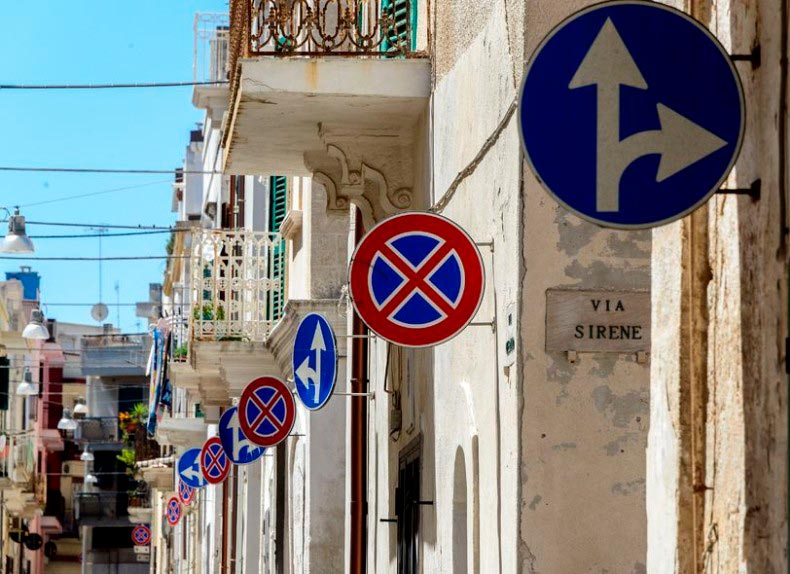Traffic signs won’t tell you everything about the driving styles across Europe. For example, in Spain, a car must be equipped with two warning signals. In the Netherlands, experienced drivers may have higher blood alcohol concentration than those with green licenses. In Norway, there is no need to carry a fire extinguisher in cars.

Even an experienced driver can feel uncertain while traveling abroad. Will traffic lights, vertical and horizontal traffic signs be able to be relied on? These should be enough to avoid breaking basic safety rules. With precaution, it is possible to guard oneself against getting an expensive ticket abroad. However, assimilating driving to the norms of specific regions can only be achieved by being acquainted with the most important traffic conditions and driving styles of varying countries.
Buckle up and get off the phone
There are some regulations are applicable across Europe. When driving, we should be in possession of our documents (driving license, registration certificate, vehicle’s technical condition). Equally important, we have to remember to fasten our seatbelts and - if you do not use a hands-free set - to reject phone calls.
Although it’s not required everywhere, it is worth it to drive with your car’s lights on, as well as to change tires from summer to winter during autumn and spring. "Winter tires", which are not yet required in Poland, have become obligatory in many countries.
In most cases, road signs inform us about speed limits. In zoned areas, generally, it is banned to exceed 50 km/h. Outside town, in rural areas, the speed limit is usually up to 90 km/h. On expressways, differences can be quite significant. For example, on some parts of the German motorway, there is no regulated speed limit. In Malta, Latvia and Finland, a limit of 80 km/h is enforced at all times. In Estonia, seasons determine the speed limit. In the summer, on expressways, 110 km/h is the limit, whereas in the winter, it can only be up to 90 km/h.
It is well-known that Great Britain is atypical of Europe by driving on the left-hand side. The United Kingdom is not the only exception on the Old Continent. While driving in Ireland, Cyprus or Malta we also have to hold tight to the left side.
After drinking it is best not to drive at all, however …
The general rule states: Have you been drinking? Do not drive! Most European countries, however, allow the margins to drive after alcohol consumption, for example, dinner with a glass of wine.
The acceptable blood alcohol concentration in Sweden is, for example, 0.2 g/l. Similar rules are practiced by their neighbouring countries of Norway and Finland, as well as in Poland. More liberal rules exist in France, Greece, Netherlands, Spain and Ireland - 0.5 g/l and 0.2-0.3 for beginning drivers. The highest tolerance is maintained by British and Maltese governments - 0.8 g/l. There are countries in Europe where you cannot afford to have even a small dose of alcohol in your blood. In the Czech Republic, Bulgaria and Slovakia the limit is 0.0.
You don't have to remember everything
In European countries, there are different regulations concerning car equipment. In Poland, only a fire extinguisher and a warning triangle are required. When we travel abroad, it is better to equip cars with reflective vests. In many countries, a first aid kit is also useful. In Croatia, drivers of cars with traditional lights must carry backup bulbs. Spanish regulations, in turn, require two portable warning triangles on the board of one car.
A road trip across Europe would involve the necessity of remembering many differing rules. Fortunately, there are available tools that allow drivers to keep an eye on ongoing rules worth knowing while travelling. Easy access to changing road rules is just a quick download away with the free Going Abroad application for all EU Member States. The application has many language versions and works on smartphones based on Android, iOS and Windows.
Drivers pay for ignorance or non-compliance
Drivers outside of Scandinavia, even with recent tightening of penalties for breaking rules, should not complain about fines if they are compared with rates in Norway, Denmark, Switzerland or the Netherlands. “Of course, the average wages between employees in European countries differ. In Poland, the average wage in the enterprise sector, translated into single currency area, is around 1k euro, while in Germany the average is 3.7k euro and in, Denmark, Ireland, Sweden, Belgium, even higher wages can be earned,” says Bartosz Grejner, financial analyst at Conotoxia. The difference in wages has not always been proportionate to fines. In some countries, violating rules costs an arm and a leg. For exceeding the speed limit of 20 km/h in Poland, drivers must pay often 100 PLN, which is about 23-24 euros. For an identical offence in the Czech Republic, the fine can be almost twice as high, in Sweden - ten times, and in Norway - up to 20 times, and according to the Conotoxia rates, this amount could reach around 1.8k PLN.
Statistically close to Germany
Recent Eurostat data (available for 2015) has shown that the ranking leaders in terms of the amount of registered cars per 1000 inhabitants are: Lichtenstein - 766, Luxembourg - 661 and Malta - 634. In fourth is Finland at 590 and Germany at 548.
“What is interesting, is that the data has shown that emerging countries have nearly caught up with more advanced economies. For instance, there are 548 registered passenger cars in Germany in 2015 - which is the biggest economy in Europe - and that number has only had a marginal increase in the five years prior. Whereas in its neighboring Poland, which is considered to be an emerging economy, that number increased by 20% over the same period. However, the data has not determined the average age and value of the cars,” adds Bartosz Grejner, analyst at Conotoxia.



